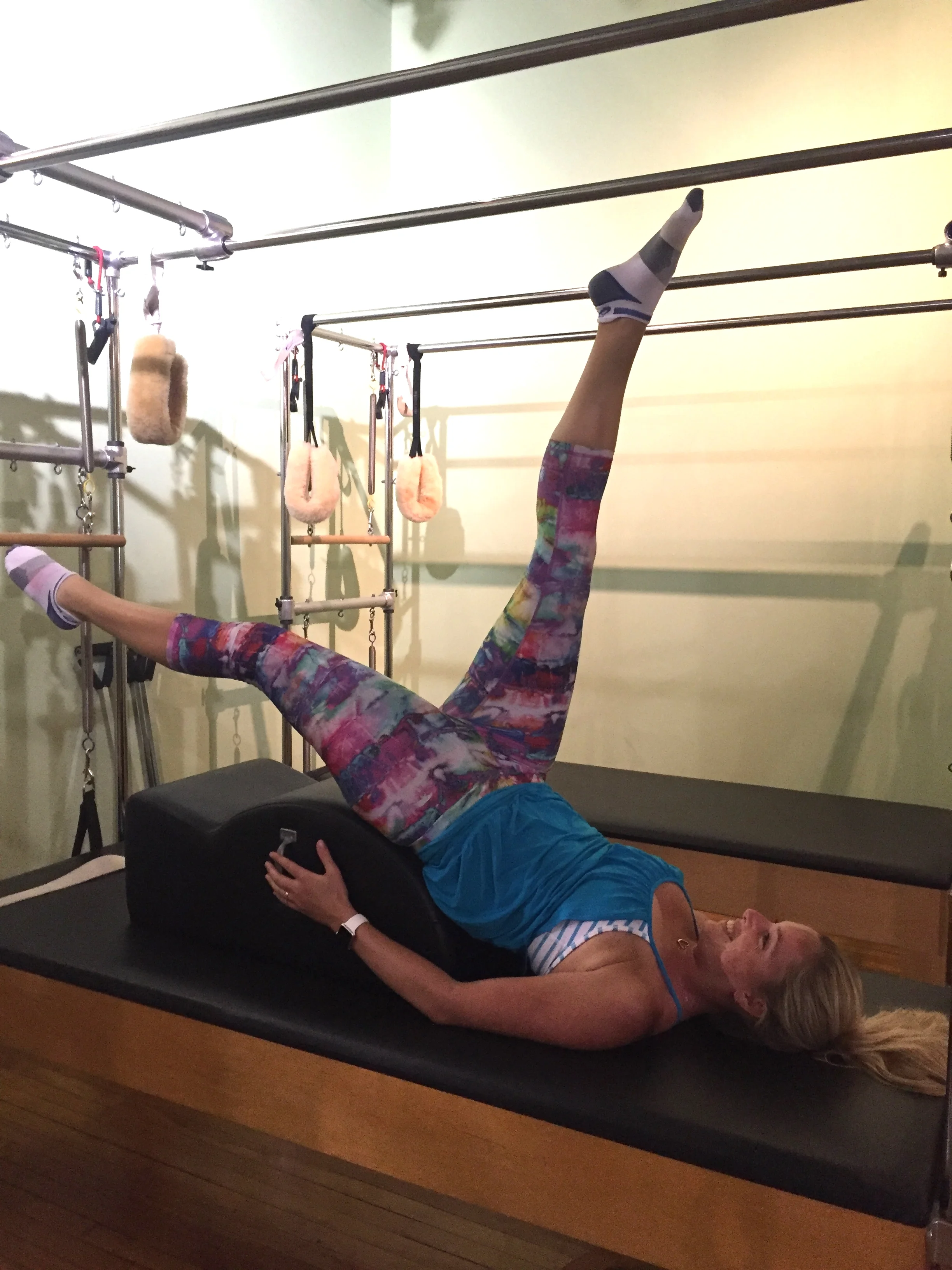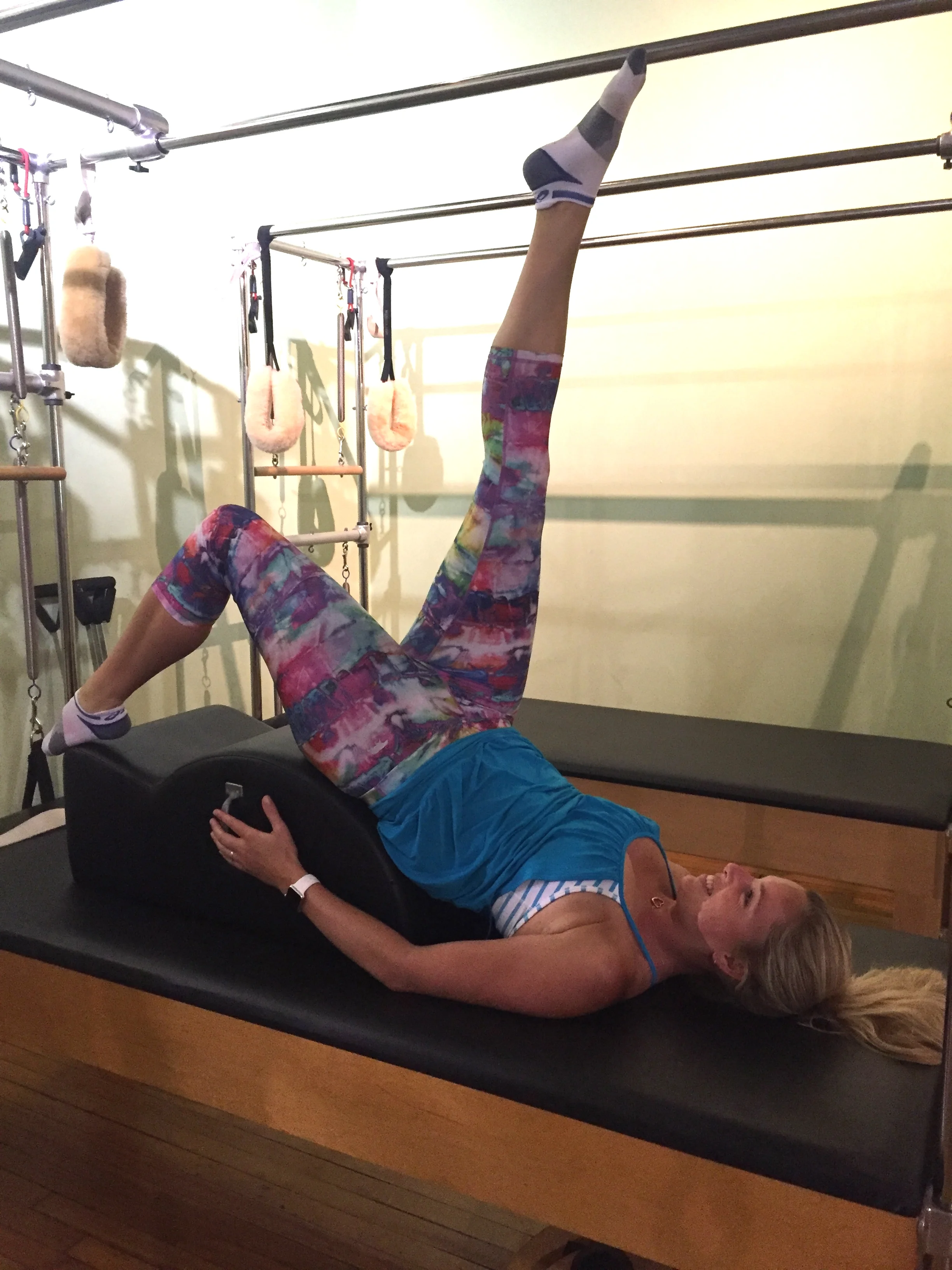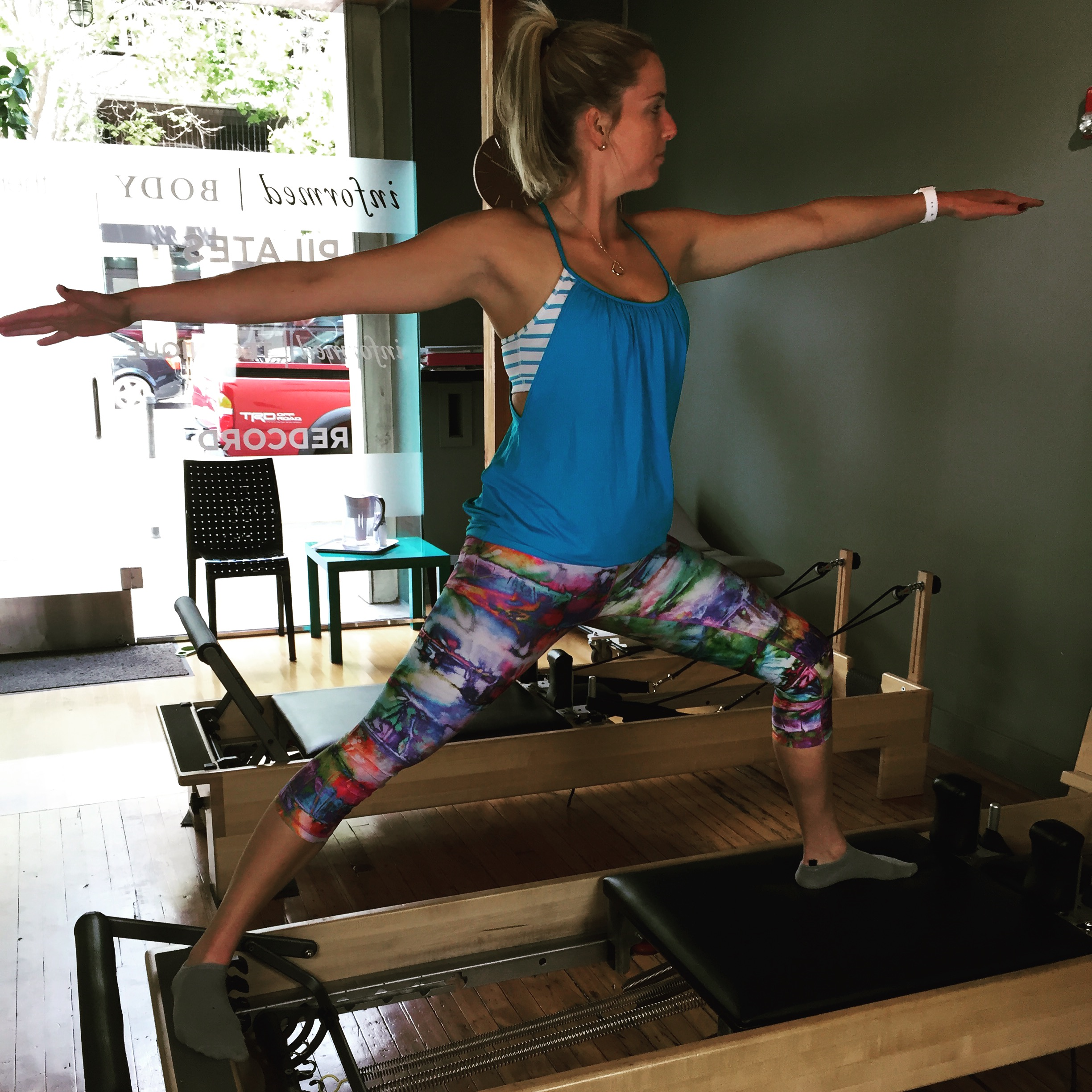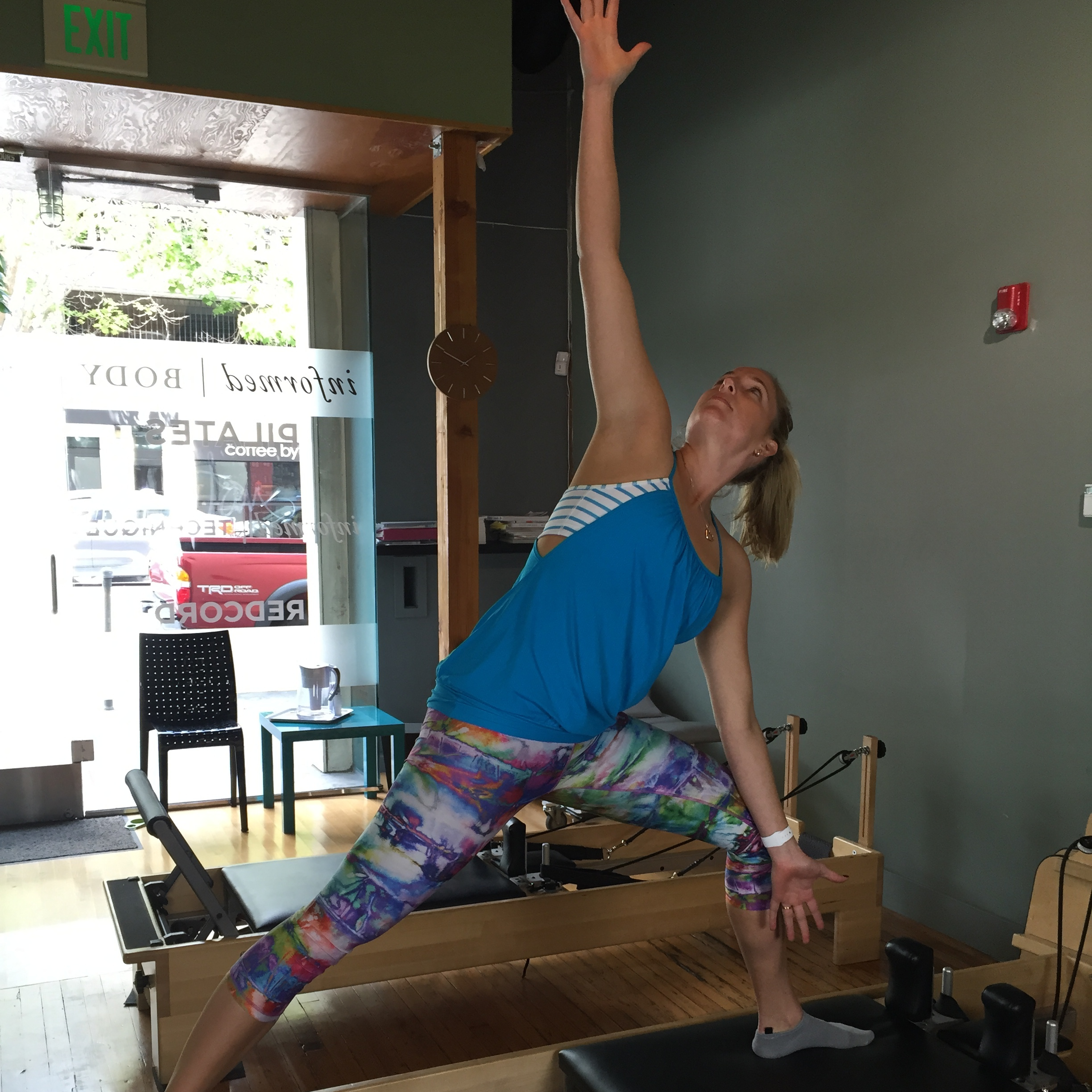Hip: Retraining mobility & dynamic motor control in Pilates
Recently I published a blog about current approaches to treating chronic pain and in that blog I discussed the Explain Pain approach to managing pain and used my personal story of chronic hip pain as an example. Firstly I'd like to thank all the readers who shared comments and sent me emails sharing their personal stories. It was so touching and humbling to receive so many kind words and messages of encouragement and positivity. With every blog I share, my aim is to help close the gap between what we are learning through science and what clinicians know and teach their patients. The research is always there to guide us but often we have to find our own way through rehabilitation programs because nothing is set in stone and no single approach is applicable to all cases.
This blog is a follow up post to outline what current rehab I am completing for my hip. It is not a program for acute hip pain but an outline of long-term rehab goals. It is a fusion of Pilates, Yoga, Functional strengthening and more physio-centric exercises. After learning that I had bony oedema and a labral tear I became fearful that my hip would be unstable and that stretching was counterproductive. Unfortunately this belief lead to a downward spiral that has resulted in both weakness and a lack of control of movement in both of my legs. Mostly from disuse and avoidance of creativity in movement. Now I know that my hip loves movement and exercise. For the past several months I have used bike riding, swimming, walking, running and stairs to improve my cardiovascular endurance and fitness. I attend Yoga which helps improve my standing balance, dynamic movement control and breathing through a wide variety of movements. However, there are still some movements where I need to apply particular focus to.
I wanted to share my top 10 exercises which help improve my mobility, dynamic movement control and restore function to my legs. Although my pain is vastly improved I still have days where I feel my leg is very tight in the front and lateral aspects. If any of these movements below become restricted I feel the same thing - hip pain. The message I've learnt is that as clinicians we always need to provide clients with a variety of tools and ways to measure how their body is travelling. These are my tools.
This program helps keep it all on track and allows me to keep training every day. Its a compilation of ideas, from experience and learning to listen to my body and focus on areas where asymmetries exist and where I feel a difference from side to side. My hope is that it provides you with some inspiration for being creative with exercises and teaching your clients how to learn where they need to focus their time. Its a forever changing program as each goal improves. The current focus is control through range of movement and ensuring full range of movement is involved in each exercise.
10 exercises for retraining hip control & mobility
- Scooter (without hands) focussing on full hip and knee extension and maintaining a strong single leg squat on the balancing leg.
- Legs and straps on the reformer: in and outs, up and downs, frogs, circles, hamstrings and quad stretch.
- Barrel or swiss ball for side abs (with foot anchored).
- 1/2 kneeling groin stretch.
- Spiky ball butt mobilisation series.
- Foam rolling for quads with bent and straight knees.
- Barrel or foam roller for scissors & bicycles focusing on hip mobility in both sides.
- Yoga extended side angle pose.
- Yoga warrior 3, arabesque hold or single leg dead lift.
- Pretzel stretch.
Let's take a look at each of these exercises, how I do them, why I love them and what I'm focussing on.
Scooter - no hands variations
Scooter has been a tough exercise for many months. To be able to get into a single leg squat position well without overcompensations through the TFL and anterior hip. To be able to position my foot and knee to create a stable base to hold the posture. The main focus is to keep that squat and then aim to kick the other leg into full extension without gripping at the front of the hip or rotating through the spine. No hands is just a great balance exercise and more functionally related to daily activities such as hill climbing and stairs which I do a lot of in San Francisco. Currently I'm focussing on hands behind head and holds overhead to bring the upper thoracic spine and shoulder girdle into play. So many fun variations that depend on what your client's functional demands are.
LEGS AND STRAPS - HAMSTRING STRETCH VARIATION:
There are many variations in the exercise legs and straps: in and out, up and down, frog legs, circles, hamstrings and thigh stretch. I've chosen to describe my personal favourites for the sake of this blog.
Legs and straps is performed on a Pilates reformer with one red & blue or two red springs. Begin by bring the legs to a 60 degree angle with knees straight. Then let one leg move higher into a straight leg raise while the other bends at the knee to move into hip flexion. Pull down with the straight leg and push with the other to return to the starting position. Alternating side to side to mobilise and strengthen the hamstring muscles.
This exercise is a great single leg variation to a double leg straight leg raise (up and downs) and can allow each side to be mobilised to an individual height. Other benefits include being able to contract the hamstring by pulling the strap down, making the mobilisation dynamic. For a harder progression neural biases can be added at the top of range by movement the ankle and leg into a peroneal or sural neurodynamic bias. If you're not sure what that means give the exercise a go and at the top bring the leg across your body pointing the ankle and rolling it inwards, then move to the opposite direction and notice how the stretching sensation moves around the leg.
LEGS AND STRAPS - THIGH STRETCH VARIATION:
Begin with both legs in straps. One red & blue or two red springs. Hold one leg straight and bend the knee to lower the other foot to the floor. Once the foot is on the floor allow the other leg to raise higher and feel the stretch through the thigh, hamstring and groin. Pull down with the straight leg and simultaneously kick up to bring the legs back to the start. Alternate from side to side.
I love this stretch because it teaches you how connected one leg is to the other. In this video you'll see me mobilising the stretch with the straight leg. Everyone will feel it where they need it but I feel it through the anterior thigh, upper groin and hamstring on the opposite side.
Side crunches on spine corrector:
I only recently started this exercise and love it because it connects the entire kinetic chain in the coronal plane. Begin with the top leg under a strap and pulling into hip abduction and ankle dorsiflexion and eversion, keeping the knee straight. Place the bottom arm behind the head or on the barrel for additional support. The top arm is raised. This allows for opening and lengthening through the torso. Lift up into side flexion working the lateral abdominal wall and lateral hip and leg muscles.
It teaches us how the ankle, knee, hip and trunk are all connected and using the leg strength to fire the lateral abdominal wall is a great way to avoid simply dumping down or compressing into the space between the ribs and hip bone. The eccentric phase creates opening and space through the ribs. If your patient is struggling to position their leg or if you don't have access to a strap the exercise can be done over a ball or barrel on the floor and you can sit behind them positioning their leg and coaching the hip abduction pattern.
Half kneeling groin stretch
Begin in a tall kneeling position and then lift one leg up and out to the side. The leg that remains on the floor is rotated inwards at the hip. With the top leg the positioning of the foot is key to where you feel the stretch. If your foot is under the knee the lunge will load into the ankle more and if it starts beyond the knee the lunge with load up into the hips. Ensure a neutral pelvic position and breathe calmly as you lunge forward into that leg moving in and out of the stretch. I love this exercise because it allows me to stretch into both sides of the groin without ever feeling like I'm over-stretching.
Spiky ball release for the posterior hip
When I first started this exercise the tightness was almost unbearable. I began purely with the first level which is a bent knee fall out. It was amazing to feel the referred pain to the front of my hip and lateral shin and realise that there were other contributing factors to my referred pain other that the labral tear and bone bruising. Such an empowering realisation.
With each day of practice the movement returned and now I can tackle the 5th level quite comfortably. On a not so great day I always come back to the exercise and it helps relieve any tightness that is limiting my mobility. It gets better with time I promise.
The five levels are:
- Bent knee fall out.
- Bent knee fall out and hip extension.
- Propped up on elbow hip slides in outward rotation.
- Propped up on elbow extended leg rotations (amazing for what feels like the posterior hip capsule).
- A more traditional gluteal/piriformis stretch. In this rotated position use the upper body to move over the ball and then sink down into super tight spots.
Foam rolling quads
This is a common exercise that many know but I love it because I can roll through any fascial restrictions with my legs bent and straight. It's remarkable how different the two positions can feel and adding in an element of hip external rotation by bringing feet together opens access to the inner quad and thigh. I often struggle with tightness through the muscles medial to Rec Fem and this is a great self mobilisation exercise. It does rely on upper body strength to pull along the floor but thats an added bonus of the exercise.
Hip scissors & bicycle kicks:
This exercise can be completed with a spine corrector or foam roller. Both are equally as comfortable and it depends on what is available to you. Begin with both legs raised in the air. Keeping them as straight as possible raise one leg above your head while lowering the other down (second image) and then swap sides. The focus in scissors is the amount of range between each leg and what you'll learn is how the hip moves into extension and how much hip flexion on one side is related to extension on the other side. Its a great exercise for coaching hip flexion through range.
In the second picture (bicycle kicks) when the bottom leg reaches end of range bend the knee and drag the foot back up to the top. It adds an extra mobilisation through the front of the thigh and is a great test for how well you'll be taking your legs into extension during hill walking and running. It's light and easy and the aim is to keep swapping from side to side, breathing well and just letting the hips slowly work through range.
Side angle pose
This exercise can be done in the more traditional sense as a yoga pose on the floor or if you're looking to make it more advanced balance on the reformer with one red and yellow spring. Side angle pose is a fantastic posture as it involves so many elements of knee flexion, hip abduction and external rotation and trunk rotation and side flexion.
For me the stretch is felt through my lower back, side of my stomach, front of the hip on the top leg and groin in the bottom leg. It is a great posture to feel how the lower back and pelvis impact mobility in the hips. Breath into the regions that are limited in this posture and feel the benefit of balance, strength and control of coupled movements. Beautiful for opening the front of the hip in a different plane of movement to a standard quad or hip flexor stretch.
Single leg arabesque / single leg dead lift / warrior 3
It comes in many names and forms but essentially practicing balancing on a straight leg and tipping forward from the hip. In yoga we practice with arms above head or hands in the centre of the chest. In the gym I tend to add arm weights into the exercise for some upper body strength. Such a great exercise to find eccentric control through the hamstrings and encourage folding through the front of the hip.
PRETZEL STRETCH
I'm sure it comes by many names but that is the name I first learnt for this stretch. It is a combination of lumbar spine rotation, opposite quadricep stretch and gets beautifully into the thoracic spine and gluteals and external rotators. Begin lying on your side with your legs bend up, the straighten the bottom leg and move into a lower back rotation stretch. Hold onto that top knee with the bottom arm. Then bend the bottom knee and reach down to grab it with the top hand. Make sure both knees are down and feet are down. The slowly rotate your upper body backwards aiming to get both shoulders to the floor. Use the breath to mobilise into the posture.
So thats my favourite 10. Hopefully this blog demonstrates how exercises approaches can be mixed together to create a program individually suited to each person. My goals are quality and control of range of movement, maintaining range throughout my leg and focussing on balance and dynamic control during strengthening exercises. Everyone has different rehabilitation goals and strategies but it is hard to come across an outline of a high-level mobility program. We all know the initial exercises for restoring function at a joint however when thinking about managing the regions above and below that joint, I would encourage you to use exercises that link these regions rather than addressing them in isolation. Everything is connected to everything and we always need to be thinking why is this a problem, not where is this the problem.
Good luck, Sian :)









